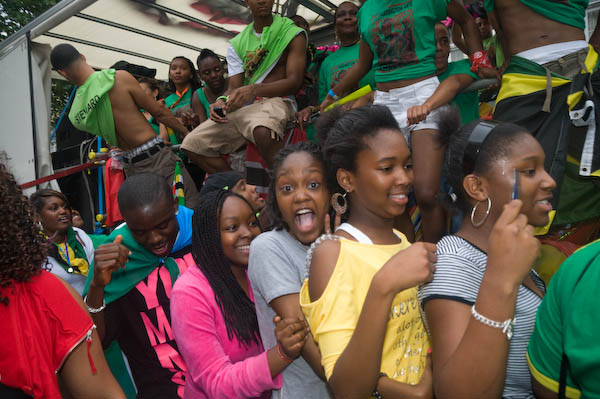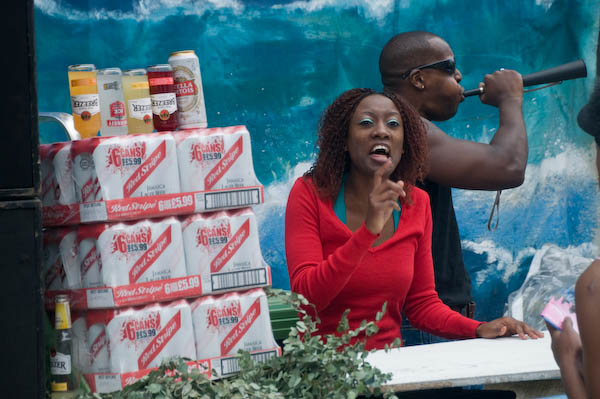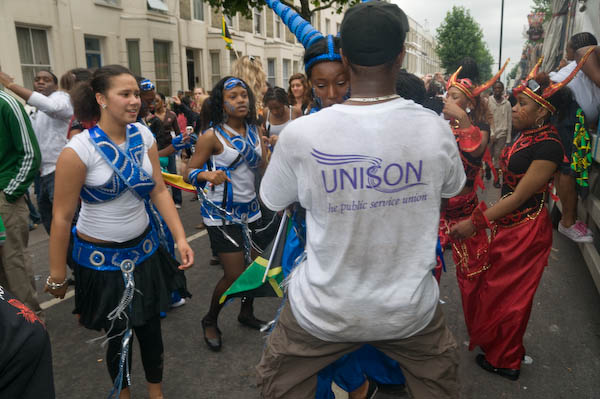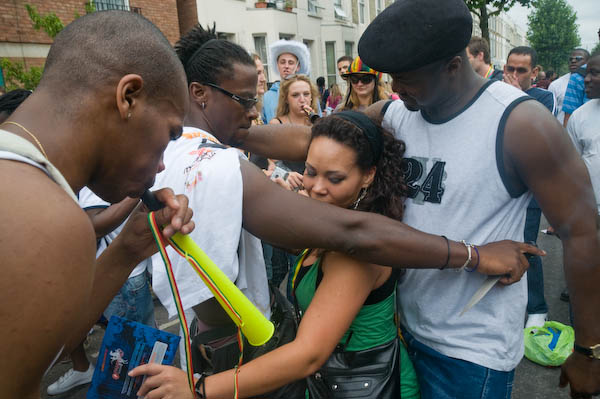Notting Hill Carnival: Here with some minor alterations is the piece I wrote for My London Diary about Carnival in 2008, with a few of the pictures. You can see many more pictures from the day on My London Diary.

There isn’t a great deal more to say about Notting Hill, although it did seem to be significantly less crowded than in recent years (some sources estimate attendance yesterday as three quarters of a million), and I walked easily through a number of areas that have usually been filled with seething masses. There did also seem to be fewer lorries and groups on the circuit than in previous years, but the big mas bands at the core of the event were out in force as usual.

Perhaps there are just too many other events on over the weekend and people were tired. Perhaps with the difficult economic times there is less funding for groups and less commercial interest (though Unison were still behind South Connections.) The weather wasn’t great either, though it didn’t rain.

Of course there are still many people who won’t go to carnival because they are scared of possible crime and violence. Police have reported that they had over 300 crimes reported to them at carnival on Monday and made around 150 arrests – considerably up on last year. With a reported 11,000 officers on duty it was still probably the safest place in the country, although I saw no sign of the metal detectors that were intended to prevent knifes being carried. In around five hours I only saw one brief incident as a young man was escorted away. The only knives I saw were plastic.

Of course carnival did go through troubled times. Its genesis was as a black response to the race riots in Notting Hill fifty years ago, although it only became a parade around the streets in 1965. In 1976 there was serious fighting when 3000 police attempted to take over and control the event and had to withdraw. Since then there have been various attempts to control and even stop carnival in Notting Hill, including the organising of alternative events elsewhere. And carnival itself has become much more managed and along with this, much safer to attend

I first went to carnival and took pictures around 20 years ago and have returned every year except one when a knee injury made it impossible (I made an effort, limping from home to our local station where I collapsed, unable to climb the footbridge, and decided I really wasn’t up to it.)

In October 2008 I took part in a show in the Shoreditch Gallery at the Juggler (now long close) in Hoxton Market, confusingly half a mile away from the site in Hoxton St where Hoxton Market is held and I was photographing Sunday’s ‘1948 Street Party‘. Hoxton Market is immediately to the north of the Holiday Inn on Old Street. The show, still online, was called ‘English Carnival’ and was a part of the East London Photomonth 2008.

The other 3 photographers, Paul Baldesare, Dave Trainer and Bob Watkins, showed pictures from ‘traditional’ English carnivals – like the Hayling Island one at the beginning of this month (August 2008), but my pictures were from Notting Hill – which now with other carnivals drawing their main inspiration from the Caribbean and elsewhere around the world is very much a part of the English carnival scene.
The work I chose for this show was a black and white portfolio of 20 images which had been previously published in ‘Visual Anthropology Review‘, where it accompanied a scholarly essay on carnival by distinguished academic, George Mentore along with his perceptive comments on my pictures.
You can see many more of my pictures from Notting Hill Carnival in two albums, Notting Hill Carnival – the 1990s and Notting Hill Panoramas -1992 and from later years on the August pages of My London Diary.
Flickr – Facebook – My London Diary – Hull Photos – Lea Valley – Paris
London’s Industrial Heritage – London Photos
All photographs on this page are copyright © Peter Marshall.
Contact me to buy prints or licence to reproduce.